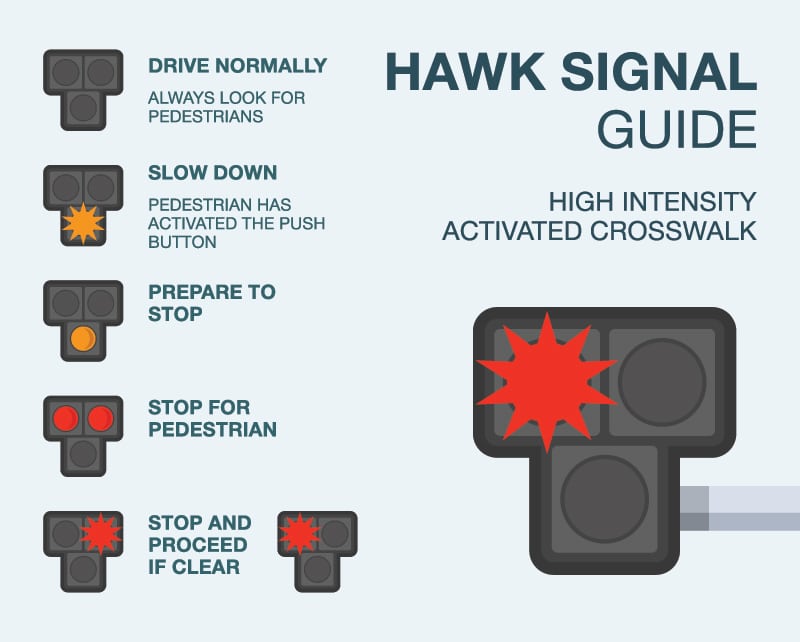How to Use HAWK Signals
Are you acquainted with the traffic signal specifically designed to enhance pedestrian safety and make crossing the road more convenient? The HAWK (High-Intensity Activated Crosswalk) signal is a groundbreaking innovation on that front, designed to streamline pedestrian crossings while ensuring that drivers remain alert and responsible.
Despite its effectiveness, many pedestrians and drivers remain unaware of how the system operates for pedestrians and drivers and the proper way to use it. Let’s explore what the HAWK signal is and how to use the HAWK signals properly.

What is a HAWK Signal?
HAWK, which stands for High-Intensity Activated crosswalk, is a type of traffic signal designed specifically to assist pedestrians in crossing busy roads safely.
HAWK signals help to reduce pedestrian deaths by providing clear and controlled access for crossing at busy roads. A HAWK signal, also known as a pedestrian hybrid beacon (PHB), is designed to enhance safety at busy street crossings.
By prioritizing pedestrian visibility and establishing a structured crossing process, HAWK signals significantly decrease the risk of pedestrian deaths and injuries at intersections.
When activated, these signals stop vehicular traffic, allowing pedestrians to cross safely while drivers receive visual cues, reducing confusion and potential accidents.
It differs from traditional crosswalks by remaining dark until activated either by a pedestrian push button or an automatic sensor. It helps manage vehicular traffic more efficiently.
These signals are particularly effective at mid-block locations and areas with high pedestrian demand, contributing to a significant reduction in pedestrian crashes.
The HAWK sites experienced an 83 percent reduction in pedestrian crashes after installation. [1]
How The HAWK Works
The High-Intensity Activated Crosswalk beacon is a traffic control device designed to enhance pedestrian safety on busy streets, particularly at mid-block locations. It operates differently from conventional traffic signals and is a safer crossing alternative.
This is how it works:
Activation: Pedestrians activate the HAWK signal by pressing a button or using an automatic sensor that detects their presence.
Signal Phases: Once activated, the HAWK signal follows a sequence:
- Dark Signal: Initially, the lights are dark, contrasting traditional pedestrian crossings and signalized intersections.
- Flashing Yellow Signal: It alerts drivers to prepare to stop.
- Solid Yellow Signal: Similar to a yellow light at a conventional traffic signal, it instructs drivers to slow down.
- Solid Red Signal: The solid red signal instructs drivers to come to a complete stop, ensuring a safe crossing for pedestrians.
- Flashing Red Signal: The flashing red light signals to drivers that they may proceed once the crosswalk is clear.

How to Use HAWK Signals as a Pedestrian
HAWK signals offer a safer alternative for pedestrian crossings. Here’s how to use these traffic control devices effectively as a pedestrian:
- Activate the Signal: Begin by pressing the pedestrian button. It sets off the HAWK signal for approaching vehicles, starting with a flashing yellow light.
- Cross Safely: Once the solid red light appears, cautiously proceed across the road. Be aware that during the flashing red phase, drivers can continue if the path is clear.
Using HAWK Signals as a Driver
Here’s how drivers should respond when they encounter a Hawk light signal:
- Flashing Yellow Signal: When a pedestrian presses the button, this signal flashes first. It indicates to drivers that the pedestrian signal has been activated, and the yellow signal will soon be solid.
- Solid Yellow Signal: Following the flashing yellow, the solid yellow signal prompts drivers to slow down and prepare to stop. It’s similar to a yellow light at a conventional traffic signal.
- Solid Red Light: When this light appears, drivers must stop completely, just like any signalized intersection, allowing pedestrians to cross safely.
- Alternating Flashing Red Light: After the solid red, this signal allows motorists to proceed through the intersection, but only if it’s safe to do so without jeopardizing pedestrian safety.
Objectives of Implementing HAWK Signals
HAWK signals improve pedestrian safety on heavily trafficked streets, especially at mid-block crossings. Here are the primary objectives of implementing HAWK signals:
- Enhance Pedestrian Safety: The primary purpose is to facilitate safer pedestrian crossings, effectively reducing the risk to pedestrians.
- Improve Traffic Flow: By activating only when pedestrians are present, HAWK signals minimize unnecessary delays for vehicular traffic, ensuring smoother traffic flow while maintaining priority for pedestrians.
- Reduce Crashes: It helps to reduce pedestrian crashes at locations with HAWK signals, marking them as a safer crossing alternative compared to traditional crosswalks.
- Optimize Installation Locations: HAWK signals are strategically placed where a full traffic signal is not warranted, such as intersections between arterial roads and smaller streets.

Effectiveness of HAWK Signals
HAWK signals effectiveness can vary, and this can be attributed to several key factors:
- Increased Visibility: These pedestrian crossing beacons often utilize bright LED lights and distinct signage, making them more noticeable to both drivers and pedestrians. This heightened visibility helps to grab the attention of motorists, prompting them to slow down and yield to pedestrians.
- Enhanced Safety: By clearly signaling when it is safe for pedestrians to cross, these signals decrease pedestrian crashes. They provide unambiguous communication that helps prevent confusion among both drivers and pedestrians, thus fostering a safer crossing environment.
- Traffic Flow Optimization: By managing the movement of both vehicles and pedestrians, activated signals can reduce congestion and enhance traffic flow.
- Data Collection and Analysis: Many advanced systems are equipped to collect traffic data, which can be analyzed to improve pedestrian safety initiatives. This data can help identify trends, times of high pedestrian traffic, and areas requiring additional safety measures.
- Community Benefits: Effective crosswalk systems enhance the walkability of neighborhoods, encouraging pedestrian activity. This can lead to increased foot traffic for local businesses and contribute to healthier lifestyles by promoting walking as a means of transportation.
If you or a loved one has suffered in a pedestrian accident, contact Goldberg & Loren’s pedestrian injury lawyers for a free consultation today.
How to Use HAWK Traffic Signals Infographic
Source:
[1] Fitzpatrick, K., & Park, E. S. (2010). Safety effectiveness of the HAWK Pedestrian crossing treatment (By Texas Transportation Institute; p. 76). Texas Transportation Institute. https://nacto.org/wp-content/uploads/FHWA-10-042-Safety-Effectiveness-of-the-HAWK-Pedestrian-Crossing-Treatment.pdf


